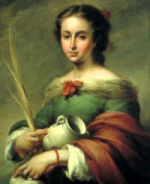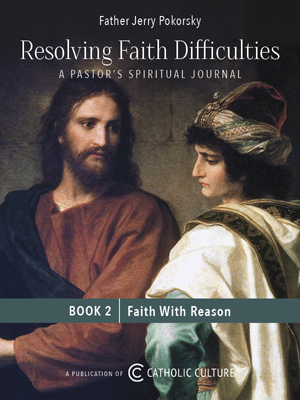Catholic Activity: Feast of the Annunciation: Origin and Traditions
Father Francis X. Weiser, S.J> from Chapter 8 of The Holyday Book explains the origin of the Solemnity and some of the traditions related to this day.
Nine months before Christmas Day, December 25, we celebrate the Solemnity of the Annunciation of our Lord.
This is another Solemnity that ordinarily falls during Lent. The Gloria and Nicene Creed are prayed during the Liturgy of the Mass. During the creed at the words "By the power of the Holy Spirit, He was born of the Virgin Mary and became man" we kneel. This day celebrates the actual Incarnation of Christ, the day the Son of God became man when Mary spoke her Fiat, or "yes" to God. St. Luke records the events:
In the sixth month the angel Gabriel was sent from God to a city of Galilee named Nazareth, to a virgin betrothed to a man whose name was Joseph, of the house of David; and the virgin's name was Mary. And he came to her and said, "Hail, full of grace, the Lord is with you!" But she was greatly troubled at the saying, and considered in her mind what sort of greeting this might be. And the angel said to her, "Do not be afraid, Mary, for you have found favor with God. And behold, you will conceive in your womb and bear a son, and you shall call his name Jesus.
He will be great, and will be called the Son of the Most High; and the Lord God will give to him the throne of his father David, and he will reign over the house of Jacob for ever; and of his kingdom there will be no end."
And Mary said to the angel, "How can this be, since I have no husband?"
And the angel said to her, "The Holy Spirit will come upon you, and the power of the Most High will overshadow you; therefore the child to be born will be called holy, the Son of God.
And behold, your kinswoman Elizabeth in her old age has also conceived a son; and this is the sixth month with her who was called barren. For with God nothing will be impossible." And Mary said, "Behold, I am the handmaid of the Lord; let it be to me according to your word." And the angel departed from her. (Luke 1:26-38)
DIRECTIONS
Chapter 8: The Annunciation
This feast, which commemorates the message of the Angel Gabriel to Mary and the Incarnation of Christ (Luke 1, 26-38), bears the official title "Annunciation of the Blessed Virgin Mary." In early medieval times it was called the "Annunciation of the Lord" or the "Conception of Christ," indicating that in those days it was considered more a festival of the Lord. Its date. March 25, is placed nine months before the celebration of Christ's birth (Christmas).
The feast was held in the Eastern Church as early as the fifth century. It was introduced into the West during the sixth and seventh centuries. The Tenth Synod of Toledo (656) mentions it as a festival already well known and universally celebrated. It was kept on the same date as in the East, March 25. In many churches of Spain, however, it was annually held on December 18. During the eleventh century the Spaniards adopted the Roman date but also retained their own, so they had two feasts in honor of the Annunciation. In the eighteenth century Rome replaced the Annunciation in December with a feast of the "Expectation of Birth of the Blessed Virgin" (meaning that Mary expected the birth of Christ). The Gospel of the new feast is still that of the Annunciation.
The name of the feast in most nations is the same as the liturgical one, either in its Latin form or in translation, like Verkündigung in German. In the Greek Church it is called Evangelismos (Glad Tidings), among the Slavs of the Eastern Rite, Blagovescenije Marii (Glad Tidings of Mary). The Slavs of the Latin Rite call it Zvestovanie Panie Marii (Message to Lady Mary), the Arabic Christians 'id al-bishara (Feast of Good News).
A popular name in central Europe is "Feast of Swallows" (Schwalbentag, Fecskek napja). It is the general belief (and usually happens) that the first swallows return from their migration on or about this day. An ancient saying in Austria claims:
When Gabriel does the message bring,
Return the swallows, comes the spring.
This coincidence might have been the reason why people in medieval Europe ascribed to the swallows a certain hallowed character. They call them "God's birds" in Hungary, "Mary's birds" in Austria and Germany; and no farmer would ever kill swallows or destroy their nests. Another reason might well have been the fact (made known in Europe by Crusaders and pilgrims) that the town of Nazareth, where the Annunciation took place, has an abundance of swallows circling the houses all day with their cheerful twittering.
The Annunciation was a feast of obligation and one of the public holydays in the Middle Ages. In Catholic countries it was so celebrated up to 1918 when the obligation of attending Mass and resting from work was rescinded by the new Code of Canon Law. In the liturgy, however, it still enjoys its character as one of the major feasts of Mary.
In the early Christian centuries March 25 was observed in a special way as the Day of the Incarnation. In order to make the Lord's life on earth an exact number of years, even down to the day, an early tradition claimed that it was also the date of the crucifixion. This fact is mentioned in many ancient martyrologies (calendars of feasts) and in the sermons of various Fathers of the Church. Soon other events of the history of our salvation were placed on this day by legendary belief, and thus we find in some calendars of the Middle Ages the following quaint "anniversaries" listed for March 25:
The Creation of the World
The Fall of Adam and Eve
The Sacrifice of Isaac
The Exodus of the Jews from Egypt
The Incarnation
The Crucifixion and Death of Christ
The Last Judgment48
It was an ancient custom of the papal Curia (executive office) to start the year on March 25 in all their communications and documents, thus calling it the "Year of the Incarnation." This practice was also adopted by most civil governments for the legal dating of documents. In fact, the Feast of the Annunciation, called "Lady Day," marked the beginning of the legal year in England even after the Reformation, up to 1752.
The scene of the Annunciation used to be represented in mystery plays. In the cathedrals of France, Italy, Germany, and England, on the feast itself, or on a Wednesday in Lent, the "Golden Mass" (Missa Aurea) was celebrated, during which the Blessed Virgin and Gabriel were represented by deacons kneeling in the sanctuary and singing the Gospel of the Mass in Latin dialogue, while another deacon sang the part of the narrator. It is reported that the Golden Mass was inaugurated at Toumay in Belgium in 1231.49
In other places the solemn Mass was followed by a procession in which a choir boy representing Mary was led through the church and the churchyard. In western Germany, a boy dressed as an angel and suspended on a rope from the Holy Ghost Hole would slowly descend inside the church and, hanging in midair, would address "Mary" with the words of Gabriel. While the children stared up at the approaching "angel" their mothers put cookies and candy on the pew benches, making their little ones believe that Gabriel's invisible companion angels had brought them these presents from Heaven.50
In the city of Rome a colorful and splendid procession used to be held on the feast day at the end of the Middle Ages. A richly decorated carriage bearing a picture of the Blessed Virgin was drawn by six black horses from Saint Peter's to Santa Maria della Minerva. There the pope celebrated a pontifical Mass and afterward distributed fifty gold pieces to each of three hundred deserving poor girls to provide them with the necessary means for an honorable and appropriate marriage.
In Russia priests would bless large wafers of wheat flour and present them to the faithful after the service. Returning home, the father would hand a small piece of the wafer to each member of his family and to the servants. They received it with a deep bow and ate it in silence. Later on in the day they took the remaining crumbs of the "Annunciation bread" out into the fields and buried them in the ground as a protection against blight, hail, frost, and drought.
In central Europe the farmers put a picture representing the Annunciation in the barrel that holds the seed grain. While doing so they pronounce some ancient prayer rhyme like this one from upper Austria:
O Mary, Mother, we pray to you;
Your life today with fruit was blessed:
Give us the happy promise, too,
That our harvest will be of the best.
If you protect and bless the field,
A hundredfold each grain must yield.
Having thus implored the help of Mary, they start sowing their summer grains on the following day, assured that no inclement weather will threaten their crops, for, as the ancient saying goes,
Saint Gabriel to Mary flies:
This is the end of snow and ice.
LITURGICAL PRAYER: O God, who didst will that Thy Word take flesh in the womb of the blessed VirginMary at the message of the angel: grant us, we pray, to be aided before Thee by her intercession, whom we believe to be truly the Mother of God.
Endnotes
48. See Herbert Thurston, S.J., "Christmas and the Christian Calendar," in American Ecclesiastical Review, vol. XIX, p. 568.
49. Karl Young, The Drama of the Medieval Church, Oxford, 1933, vol. II, pp. 245 ff.
50. Gugitz, Das Jahr und seine Feste, vol. I, p. 147.
Activity Source: Holyday Book, The by Francis X. Weiser, S.J., Harcourt, Brace and Company, Inc., New York, 1956






